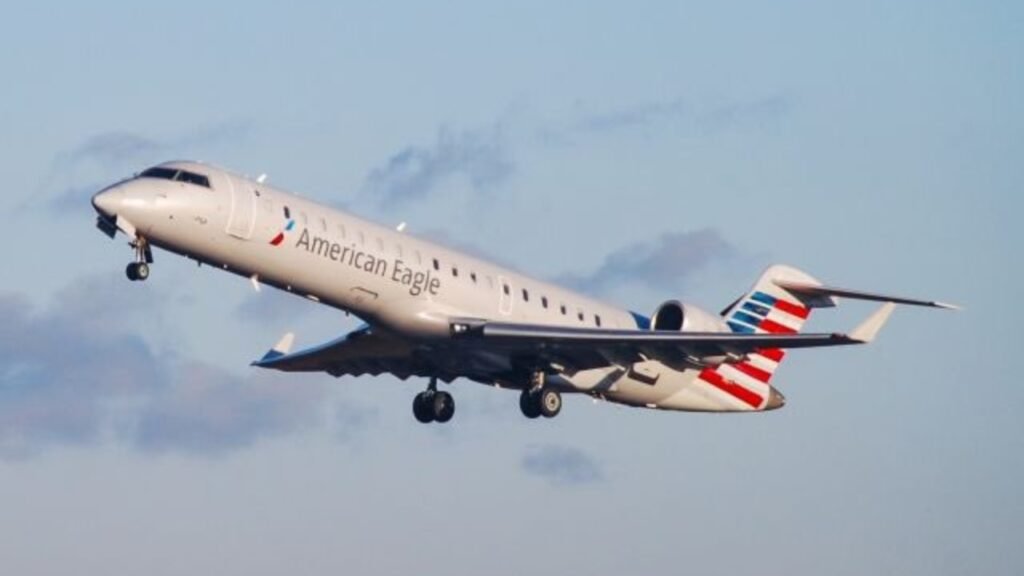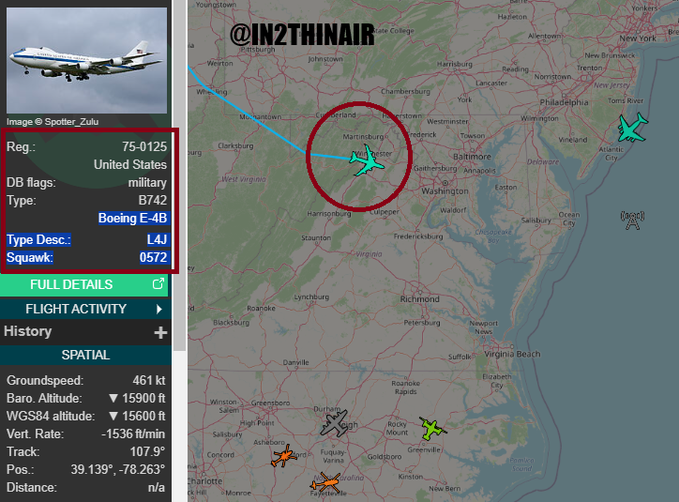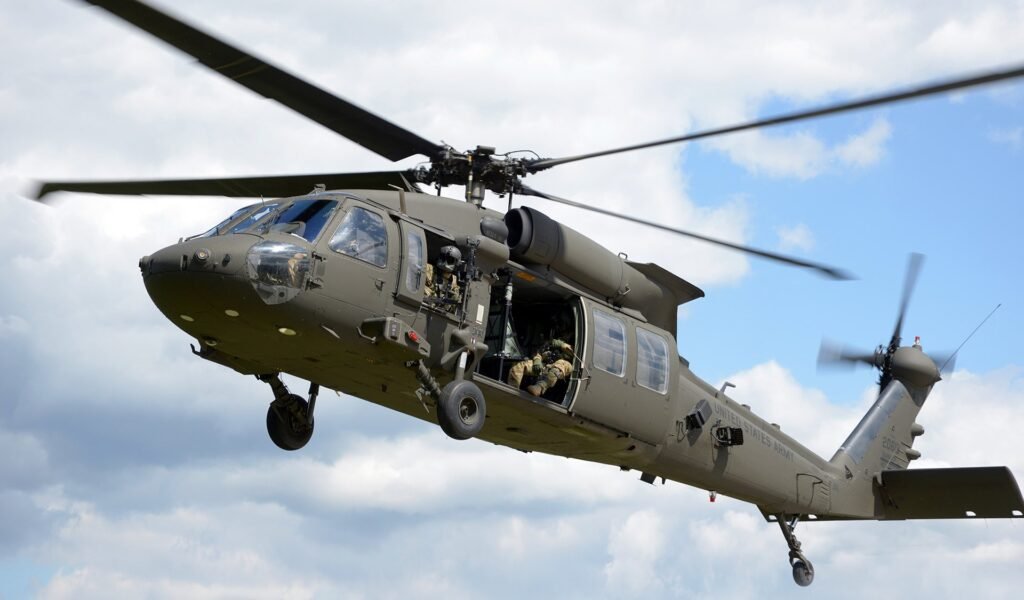Terror In The Skies: What Caused The Reagan National Mid-Air Collision?
- Leave a Comment
- James M
- January 30, 2025

Around 9 p.m. ET on Wednesday, a U.S. Army Black Hawk helicopter and an American Airlines regional plane crashed over the Potomac River, resulting in a terrible mid-air accident close to Ronald Reagan Washington National Airport (DCA). Both airplanes plunged into the frigid waters as a result of the crash, prompting a swift and extensive emergency reaction.
The commercial jet, registered as PSA Airlines Flight 5342, was on final approach to Runway 33 at Reagan National when it collided with the military helicopter, according to confirmation from the Federal Aviation Administration.
Three Army servicemen were on board the Sikorsky UH-60 Black Hawk, while 60 passengers and four crew members were on board the American Airlines Bombardier CRJ700. Witnesses claimed to have seen debris fall into the river after a fireball appeared in the night sky.
The EarthCam network’s live footage of the impact showed a brilliant explosion shortly before both planes vanished from view. As emergency personnel raced to the site, Reagan National Airport officials quickly announced a ground stop, stopping all takeoffs and landings.
Fireboats, helicopters, and dive teams are searching the cold Potomac River for survivors as part of ongoing rescue efforts. The fate of many people is still unknown, but at least four have been rescued from the water and sent to nearby hospitals.
There were severe worries about hypothermia for anyone who might still be in the water because the water was only about 35°F (1.6°C) when the crash occurred. Rescue teams have been sent out by first responders from Alexandria, Arlington County, and Washington, D.C., to help with the urgent search.
To ascertain the cause of the mid-air collision, the National Transportation Safety Board (NTSB) and the Federal Aviation Administration (FAA) have initiated a comprehensive aviation accident investigation. Despite the fact that there are currently no signs of terrorism or criminal activities, the FBI’s Washington Field Office has also been briefed.
The investigation will be headed by the NTSB, which will examine radar files, flight data recorders, and air traffic control communications to determine how this tragic incident happened. Authorities are warning the public to stay away from the area close to Gravelly Point, where emergency workers have established a command center, while rescue and recovery operations continue.

Information about the Airborne Collision Close to Reagan National Airport
A U.S. Army Sikorsky H-60 Black Hawk helicopter and a PSA Airlines Bombardier CRJ700, flying as American Airlines Flight 5342, were engaged in the mid-air collision. Carrying 60 passengers and four crew members, the American Airlines regional jet was a twin-engine commercial aircraft built for short-haul travel.
On its way to Ronald Reagan Washington National Airport (DCA), the plane had taken off from Wichita Dwight D. Eisenhower National Airport (ICT) in Kansas. Three Army servicemen were on board the Sikorsky UH-60 Black Hawk, a military transport and utility helicopter, when the two planes tragically crossed paths while they were on a training or operational mission.
At Reagan National Airport, one of the busiest airports in the area surrounding Washington, D.C., American Airlines Flight 5342 was making its final approach to Runway 33 when the incident happened. According to preliminary accounts, the Black Hawk helicopter was also moving in the vicinity when it collided with the PSA Airlines flight, which was descending at a low altitude.
Investigators are examining radar files and flight data to ascertain what caused the fatal accident, although the Federal Aviation Administration (FAA) has not yet confirmed whether the helicopter received the appropriate clearance from air traffic control.
As the two planes crashed, passengers on other flights and onlookers on the ground reported seeing a fireball in the night sky. The collision was captured on video by EarthCam’s webcam network, which is located along the Potomac River.
The footage showed a bright explosion followed by debris falling into the river. Larger pieces of the fuselage were still floating when rescue crews arrived, and the wreckage of both planes was strewn over the river. In order to concentrate on the emergency response, the Metropolitan Washington Airports Authority (MWAA) promptly issued a ground stop at DCA and halted all flight operations.
The sequence of events leading up to this devastating mid-air collision is currently being investigated by the FAA and the National Transportation Safety Board (NTSB). ATC (air traffic control) communications, flight data recorders, and cockpit voice recordings are being examined by officials to determine whether pilot mistake, misunderstanding, or mechanical failure were involved.
Although the FBI’s Washington Field Office has also been briefed, there is yet no proof that the crash was connected to terrorism or criminal intent. While recovery efforts continue, authorities are warning the public to stay away from the Gravelly Point area.
🚨 #BREAKING: President Trump just gave a seemingly alarming update on the plane crash in DC
— Nick Sortor (@nicksortor) January 30, 2025
“The helicopter was going straight at the airplane for an extended period of time. It is a CLEAR NIGHT…”
😳 pic.twitter.com/ahQbaeY1Xc
Recovery and Rescue Activities After a Mid-Air Collision Close to Reagan National
Within minutes of the mid-air accident near Ronald Reagan Washington National Airport (DCA), first responders, fireboats, and helicopters rushed to the Potomac River as part of the emergency response. Search and rescue crews from Alexandria, Arlington County, and Washington, D.C., coordinated attempts to find survivors as debris from American Airlines Flight 5342 and the U.S. Army Black Hawk chopper strewn across the lake.
The U.S. Coast Guard helped in recovery efforts, and the D.C. Fire and EMS Department and the Metropolitan Washington Airports Authority (MWAA) sent out several rescue vessels. In order to provide emergency personnel complete access to Reagan National Airport, authorities quickly implemented a ground stop, stopping all takeoffs and landings.
Even with the quick reaction, crash victims were at serious risk due to the freezing water’s temperature of 35°F (1.6°C). Under such circumstances, hypothermia can develop in as little as 15 to 20 minutes, so time is crucial to the life of people who were ejected from the airplane. While paramedics on shore gave emergency medical care, divers and rescue crews battled desperately to extract people from the cold waters.
Along the Potomac River, the search area was enlarged, and boats fitted with sonar were used to look for any further survivors and submerged wreckage. In order to find body heat signatures in the dark, icy water, helicopters fitted with infrared cameras flew over the region.
At least four people have reportedly been pulled from the Potomac River and sent to nearby hospitals for medical attention. According to emergency officials, they are receiving immediate medical attention, but their situations are still unknown. Rescue crews are still searching both aircraft for missing passengers and crew members, therefore the exact number of victims has not yet been established.
Recovery attempts are made more difficult by the fact that the Black Hawk chopper and the wreckage of American Airlines Flight 5342 are still partially submerged. There is a large debris field, and some portions of the aircraft may be flowing downstream, according to authorities.
As their investigation into the mid-air accident gets underway, the National Transportation Safety Board (NTSB) and the Federal Aviation Administration (FAA) are keeping a careful eye on the rescue and recovery efforts. Despite the fact that there is currently no indication of terrorism or criminal activity, the FBI’s Washington Field Office has also been briefed.
Boaters and locals living close to the Potomac River have been asked by officials to report any floating debris or wreckage. In the wake of this tragic airplane accident, the country closely monitors the efforts of rescue teams as they search for survivors, hoping for more incredible rescues.
Trump's honest statement on the plane crash. Says what we're all thinking and saw with our eyes. Biden would still be 🤫😴. pic.twitter.com/PktZdMos0u
— Owen Shroyer (@OwenShroyer1776) January 30, 2025
Governmental organizations have begun a thorough investigation of the mid-air accident that occurred between American Airlines Flight 5342 and a U.S. Army Black Hawk helicopter close to Ronald Reagan Washington National Airport (DCA). White House officials are keeping a close eye on the ongoing rescue and recovery efforts in the Potomac River, and President Donald Trump has been updated on the situation.
The investigation has been taken over by the National Transportation Safety Board (NTSB) and the Federal Aviation Administration (FAA), with the NTSB spearheading attempts to identify the cause of the accident. There is currently no evidence of terrorism or criminal behavior connected to the incident, according to the FBI’s Washington Field Office, which has also been involved.
The American Airlines-operated PSA Airlines Flight 5342 was making its last approach to Runway 33 at DCA when it collided with the Sikorsky UH-60 Black Hawk, according to an early statement issued by the Federal Aviation Administration. Investigators are concentrating on determining if pilot mistake, mechanical failure, or a misunderstanding by air traffic control played a role in the disaster.
To investigate every potential component, the NTSB has sent out a team of aviation professionals, including experts in flight operations, aircraft constructions, air traffic control protocols, and weather. The military’s aviation safety section will investigate the Black Hawk helicopter, while the CRJ700 jet’s flight data recorder (FDR) and cockpit voice recorder (CVR) will be examined for any pertinent information.
The air traffic control protocols in the extremely crowded airspace of Washington, D.C., are a major topic of examination. Investigators are examining whether controllers at Reagan National Airport (DCA), which is noted for its intricate flight pathways, appropriately coordinated flight clearances between the Army chopper and the PSA Airlines jet.
Officials are also investigating if the mid-air accident was caused in any way by the nation’s capital’s stringently enforced restricted airspace laws. To find out whether there were any warnings or missed signals prior to the disaster, radar logs and ATC conversations will be examined.
Airport operations have been severely disrupted by the mid-air collision between American Airlines Flight 5342 and a U.S. Army Black Hawk helicopter near Ronald Reagan Washington National Airport (DCA). To facilitate rescue and recovery efforts, DCA authorities temporarily suspended all airport takeoffs and landings in the immediate aftermath of the collision.
Passenger planes were stopped while emergency personnel rushed to the crash site in the Potomac River, affecting a large number of flights. Because flight operations at Reagan National are closely linked to air traffic hubs nationwide, this has had a cascading effect.
Thousands of travelers passing through Washington, D.C., on Wednesday night were impacted by the substantial delays and cancellations brought on by DCA’s temporary closure.
Inbound aircraft had to be rerouted to neighboring airports like Dulles International Airport (IAD) and Baltimore/Washington International Thurgood Marshall Airport (BWI), while numerous planes that were supposed to depart from Reagan National were delayed, according to airline representatives.
Both domestic and foreign planes saw additional delays as airport officials attempted to clear a backlog of flights when air activity began later in the evening. Although airport operations are gradually returning to normal, airlines are still keeping an eye on the situation. It is anticipated that the full impact on flight schedules will not be realized for several days.
Airlines, including American Airlines, have been providing assistance and rebooking options to impacted passengers in an effort to lessen the inconvenience of the disruption. American Airlines customer care representatives are working at DCA and other affected airports to help customers with their needs, and travelers whose flights were canceled or delayed have been given priority for rebooking on the next available flights.
Additionally, in situations where lengthy delays necessitated overnight stays, travelers were granted hotel accommodations and meal vouchers. Although providing prompt help to individuals in need has been the airline’s top priority, passengers are reminded to visit the airline’s website and customer service channels for updates on the status of their flights.
Regarding the ongoing interruptions to air travel, the Federal Aviation Administration (FAA) has also issued recommendations, advising travelers to maintain communication with their airlines and exercise flexibility while operations continue to return to normal.
Travel delays are anticipated to continue in the upcoming hours as a result of the incident investigation and the process of restoring regular air traffic flow, even though Reagan National Airport has resumed limited operations.
Airlines and aviation authorities are concentrating on giving impacted passengers the support they need while maintaining safety and security protocols during the investigation of this sad mid-air collision as they attempt to return things to normal.

The National Transportation Safety Board (NTSB) is leading the investigation into the mid-air collision between American Airlines Flight 5342 and the U.S. Army Black Hawk helicopter. A thorough examination of the flight data recorders and cockpit communications from the military helicopter and commercial plane has already been started by the NTSB.
These crucial pieces of evidence will shed light on the last moments leading up to the collision, assisting investigators in determining whether the tragedy was caused by mechanical failure, pilot mistake, or a misunderstanding between air traffic controllers.
In order to determine whether interactions between the cockpit and controllers during the aircraft’s approach to Ronald Reagan Washington National Airport (DCA) were timely and clear, investigators are also examining air traffic control (ATC) transcripts.
The NTSB will examine the flight data and assess the safety procedures for commercial and military aircraft operating in the Washington, D.C., area. Concerns over possible weaknesses in air traffic safety protocols have been highlighted by the collision between a military helicopter and a passenger jet.
Examining whether present air traffic laws effectively handle the challenges of controlling airspace over densely populated areas—particularly when military and civilian aircraft fly nearby—will be the main focus of the investigation.
It’s probable that the NTSB will make suggestions for improved practices, like as stronger airspace coordination and improved communication protocols, to stop incidents like this from happening again.
Authorities in the Washington, D.C., area are also thinking about perhaps altering public safety protocols while the inquiry is ongoing. Experts have questioned the safety of air traffic restrictions in an area that sees a high amount of both military and civilian flights due to Reagan National Airport’s (DCA) close proximity to the nation’s capital.
Authorities in the Washington, D.C., area are also thinking about perhaps altering public safety protocols while the inquiry is ongoing. Experts have questioned the safety of air traffic restrictions in an area that sees a high amount of both military and civilian flights due to Reagan National Airport’s (DCA) close proximity to the nation’s capital.
The cooperation of military and civilian aircraft in shared airspace will be a major area of inquiry. In order to prevent similar accidents in the future, the mid-air collision emphasizes the necessity of enhanced surveillance and improved communication between military personnel and air traffic controllers.
In order to improve military-civilian flight coordination and guarantee that safety procedures are observed while military helicopters are flying close to commercial flight paths, the FAA is anticipated to collaborate closely with the Department of Defense.
Both the FAA and the NTSB seek to raise aviation safety standards and stop future collisions in the intricate airspace surrounding Washington, D.C., by reevaluating current air traffic laws and safety systems.
Conclusion:
The tragic mid-air collision between American Airlines Flight 5342 and a U.S. Army Black Hawk helicopter near Ronald Reagan Washington National Airport (DCA) has had a significant impact on both the aviation industry and the country at large.
The fatalities and the continuous hunt for missing passengers and crew members highlight how vital it is to guarantee the security and safety of air travel. The aviation industry is forced to face the harsh fact that accidents can happen even in the most strictly regulated airspaces, serving as a reminder of the inherent perils of air travel as rescue crews continue their work in the Potomac River.
Finding the reasons behind this tragic tragedy is just one of the goals of the ongoing investigations by the FBI, FAA, and NTSB. Another is making sure that future catastrophes don’t happen. In areas like Washington, D.C., where military and commercial aircraft fly in close proximity, this occurrence has brought up important issues about air traffic control.
To find areas for improvement and create safety procedures that better handle the complexity of contemporary air traffic, it will be essential to continue to investigate and analyze cockpit communications, flight data, and ATC protocols.
It is impossible to overestimate the significance of better air traffic control, especially in crowded and complicated areas like Washington, D.C. Preventing similar mishaps requires clear communication between air traffic controllers and pilots, as well as coordination between military and civilian flights.
The aviation sector has a shared obligation to strengthen safety protocols, improve communication systems, and make sure that airspace management changes to accommodate the increasing needs of both military and civilian aircraft as it attempts to learn from this catastrophe. Through these endeavors, it is hoped that the lessons learnt from this tragic incident can result in a future when everyone can travel by air with even greater safety.
